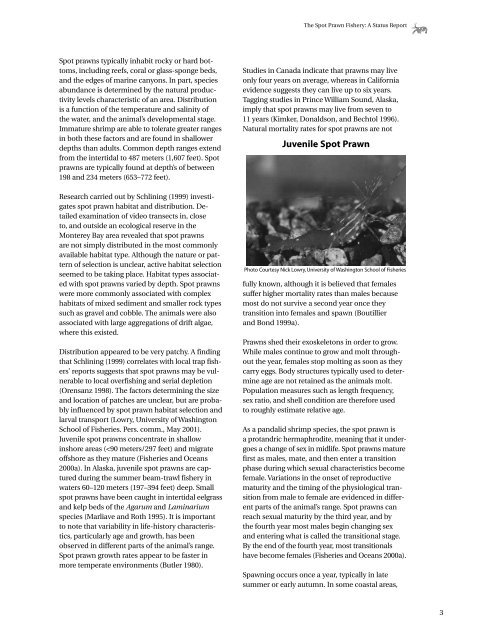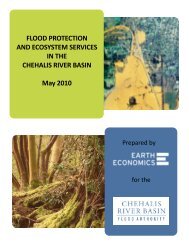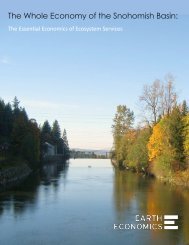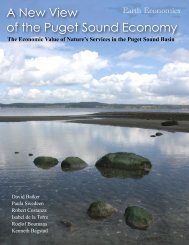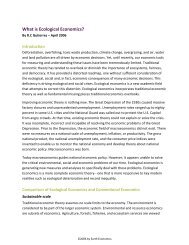The Spot Prawn Fishery: A Status Report - Earth Economics
The Spot Prawn Fishery: A Status Report - Earth Economics
The Spot Prawn Fishery: A Status Report - Earth Economics
Create successful ePaper yourself
Turn your PDF publications into a flip-book with our unique Google optimized e-Paper software.
<strong>The</strong> <strong>Spot</strong> <strong>Prawn</strong> <strong>Fishery</strong>: A <strong>Status</strong> <strong>Report</strong><br />
<strong>Spot</strong> prawns typically inhabit rocky or hard bottoms,<br />
including reefs, coral or glass-sponge beds,<br />
and the edges of marine canyons. In part, species<br />
abundance is determined by the natural productivity<br />
levels characteristic of an area. Distribution<br />
is a function of the temperature and salinity of<br />
the water, and the animal’s developmental stage.<br />
Immature shrimp are able to tolerate greater ranges<br />
in both these factors and are found in shallower<br />
depths than adults. Common depth ranges extend<br />
from the intertidal to 487 meters (1,607 feet). <strong>Spot</strong><br />
prawns are typically found at depth’s of between<br />
198 and 234 meters (653–772 feet).<br />
Research carried out by Schlining (1999) investigates<br />
spot prawn habitat and distribution. Detailed<br />
examination of video transects in, close<br />
to, and outside an ecological reserve in the<br />
Monterey Bay area revealed that spot prawns<br />
are not simply distributed in the most commonly<br />
available habitat type. Although the nature or pattern<br />
of selection is unclear, active habitat selection<br />
seemed to be taking place. Habitat types associated<br />
with spot prawns varied by depth. <strong>Spot</strong> prawns<br />
were more commonly associated with complex<br />
habitats of mixed sediment and smaller rock types<br />
such as gravel and cobble. <strong>The</strong> animals were also<br />
associated with large aggregations of drift algae,<br />
where this existed.<br />
Distribution appeared to be very patchy. A finding<br />
that Schlining (1999) correlates with local trap fishers’reports<br />
suggests that spot prawns may be vulnerable<br />
to local overfishing and serial depletion<br />
(Orensanz 1998). <strong>The</strong> factors determining the size<br />
and location of patches are unclear, but are probably<br />
influenced by spot prawn habitat selection and<br />
larval transport (Lowry, University of Washington<br />
School of Fisheries. Pers. comm., May 2001).<br />
Juvenile spot prawns concentrate in shallow<br />
inshore areas (


